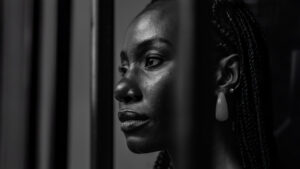I had two grandpas. The first was a friend of the bottle. He regularly enacted domestic violence against his wife, after sipping his wine. The other, his older brother, glued to the cigar, routinely received violence from his wife. Two men: one a perpetrator; the other a recipient of domestic violence. Rightly so, cries abound against the first man. But sadly the second man was only ever attended by scorn and silence.
Domestic violence against men is more frequent than many of us realise.
Domestic Violence Against Men Exists
The above scenario is not uncommon. Domestic violence against men is more frequent than many of us realise. It is a silent but sinister sin that slices the souls of some men. This article briefly surveys the prevalence of this problem on the African continent and beyond. Then I will offer some guidance for how pastors might shepherd men who are victims.
My experience with the two grandpas mentioned above stands contrary to what popular media presents—a somewhat one-sided story. Think about it. When you see a giant billboard appealing for solidarity against gender-based violence (GBV), who do you see? A battered man? One bruised by a baker’s rolling stick? I thought not. And this is not limited to billboards. Just search for the definitions of domestic violence and see what you find.
The Near-Silent Pandemic
The 2006 Uganda Demographic and Health Survey (UDHS) defined gender-based violence as “violence against women”. So does Women’s Aid. With this mindset, UDHS did not include statistics of violence against men until 2006. It was not until 2014 that the Kenya Demographics and Health Survey (KDHS) reported men as victims of domestic violence.
To date, Tanzania, the Democratic Republic of Congo, Nigeria, Zambia, Ethiopia, Zimbabwe, and Malawi, among many other African countries, do not include violence against men in their DHS reports. The same goes for the 2016 South African DHS, which, after citing an all-inclusive United Nations definition of domestic violence, proceeds to exclude any mention of male victims.
In Africa, violence against men is largely muted and even unnamed.
It is as though in Africa violence against men is largely muted and even unnamed. The popular picture of a male villain and female victim propagates societal stigma and silence against male sufferers. No wonder then that my grandpa wandered from place to place as one whose home was ghost haunted. There were whispers of him from locals. Some were sad but most were sarcastic. His was the fate of one who was not ‘man enough.’
Domestic Violence Against Men: The Statistics
But the silence does not indicate a lack of violence against men. The 2006 UDHS Report found that 53% of men (compared with 60% of women) suffered physical violence. Five years later, the same survey states, “56% of women and 55% of men age 15-49 have experienced physical violence since age 15.” The 2016 UDHS even suggested that more men (52%) suffered domestic violence than women (51%). The 2014 Kenyan DHS shows 45% of women and 44% of men suffer physical violence. The 2018 Cameroon DHS states that an equal number of men and women suffer from domestic violence (40%).
Emotional abuse is the foremost, followed by physical, and then sexual abuse.
Men suffer violence from teachers, mothers, fathers, and ‘others.’ But unlike Kenya, about 44% of Ugandan men suffer violence at the hands of their spouses, according to both current (2016) and former (2011) UDHS. The 2016 UDHS reports that 23% “of ever-married men say that they are afraid of their current or most recent spouse/partner some or most of the time.” According to many of these reports, emotional abuse is the foremost, followed by physical, and then sexual abuse. This widespread violence against men is occasionally fatal, evidenced by the Ugandan Police Reports from 2013 and 2015.
Are Men Always Guilty?
It is not uncommon for men to receive blanket blame for their woes. Regarding domestic violence, the underlying assumption is that women are not innately violent and only retaliate to provocation. Yet the statistics suggest that women may be equally as violent as men, sometimes more. A survey by Harvard Medical School states how, “both men and women agreed that men were not more responsible than women for intimate partner violence.”
The underlying assumption is that women are not innately violent and only retaliate to provocation.
The US Centre for Disease Control (CDC) states that “97% of men who experienced rape, physical violence, or stalking by an intimate partner had only female perpetrators.” And another study reveals that “50% of those who initiate aggression are women,” which can be verified by other studies.
Christians should not be surprised by these statistics. Genesis 3:16 warns us that the result of Adam and Eve’s disobedience includes the woman’s sinful urge to control, manipulate, and dominate her husband. The syntactical parallel between Genesis 3:16 and Genesis 4:7 makes this clear. Women can be as violent as men.
How Then Shall We Shepherd?
Considering the above, all believers, but especially pastors, should intentionally seek how to serve male sufferers of domestic violence. There are a few things to call to mind.
Pastors do well to know the helplessness of some of their publicly smiling but privately scorned parishioners.
Seek Out The Silently Hurting
First, pastors need to know the possibility that many men in their pews are silently hurting. And they have nowhere to turn due to societal stigma. My grandfather’s experience taught me that much. But countless stories abound of men seeking help from the police, who either laugh at or ignore them, even threatening to put them behind bars. That we blame men for the violence done against them contributes significantly to their suffering in silence as well as their fear to openly speak about their woes.
Pastors do well to know the helplessness of some of their publicly smiling but privately scorned parishioners.
Apply Gospel Hope Gently
Secondly, pastors should magnify the gospel for their congregation to show how Christ’s wounds can heal their hurts. The gospel must be vivid. Pastor, preach the gospel in such a way that you might show how, for example, Jesus’s scars heal my grandpa’s heart. Please, paint the picture and provide hope as you apply the gospel gently to aching souls.
Christ’s wounds can heal their hurts.
Establish Safe Spaces
Thirdly, because of the issue’s sensitivity, safe spaces should exist where men can talk and have emotional, psychological, and spiritual support. These must be spaces where men find confidentiality, empathy, sympathy, and healing. It is where the gospel begins to flow through the veins.
Strive For Restored Relationships
Fourth, pastors should aim at restored relationships, supporting families to heal. They should help to ensure that the hurt does not develop into anger and resentment towards women. Please clarify how abuse is a sin rather than a gender issue. Then, tell how the gospel refurbishes God’s design for male-female relationships and transforms them from self-centred manipulation of their partners to other-centred sacrificial love.
Ensure that the hurt does not develop into anger and resentment towards women.
Of course, in doing the above we must not overlook or minimise the pain and hurt of women in our congregations. For we know that many of them also suffer silently. Our aim must always be to heal and comfort the hurting. But we must not go about this in a way that ignores many who are hurting, denying that their plight even exists.














